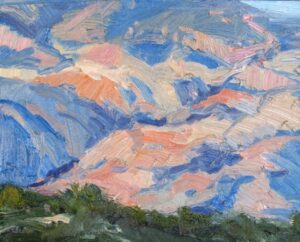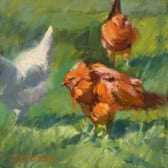
When I first considered making a contribution to the blog, it was with the thought of talking about the amazing and exceptional way Richeson manufactures our Oil Paint. I say that a bit tongue in cheek, because as a salesperson I know virtually every manufacturer will say the same. From my comfortable perch on this train I feel far more inclined to delay what I truly believe is a justifiable “sell job” for a future blog. Instead I would prefer to share with you a secret about the many many manufacturers and retailers that make or sell the many ranges of Mediums you use in the pursuit of your passion.

You see……many are artists in their own right who have ventured into the strange land of making or selling art materials out of a desire to stay close to the artist community as they earn a living and yet while under cover of darkness they pursue their art after working hours. I also know many folks involved in manufacturing who got their start as frustrated artists desperate to improve the quality of a medium but were frustrated with the materials available to them.

There is however a dark side to the secret I share with you. An ugliness has been creeping into the passionate Retailer and Manufacturer’s pursuit to serve the Artist Community. The never ending push to drive down the cost of artist materials over the recent years is at risk of seriously impacting quality. You may well ask……Is competitive price reduction such a bad thing? After all…..I confess…..I too must shop for the best value I can afford.


So where is all this rambling on a long train ride from London to Edinburgh heading? It leads me first to reflect on my own guilt at too often purchasing solely on price and neglecting quality, only to later grumble and moan because the silly thing has not functioned or lasted as I expected. I chide myself and renew a commitment to purchase the finest quality widget or thing I can possibly afford for the money available to me.

Enough rambling from my seat on a train in the British Countryside. Next time I will expound on our passion at Richeson for producing only the finest Oils available at a price that is affordable without the need to take out a second mortgage!!!!
Oil Painting
What Next?

The novice painter may set as his goal the ability to transcribe in paint what is in front of him. The novice truly believes at the time that if he can do that he will be happy. And for many painters, that’s as far as they get. For others, however, they quickly learn that just painting the image “as is” does not feed their expressive souls. They begin to search for ways to paint “better.”
For those who will paint better, this stage is both painful and exhilarating at the same time. Here’s where, if we are willing to search deep within ourselves and search for information on the masters of the past, we can grow into a richer life as painters; a life that will sustain us for a lifetime.

Is this stage the last stage? I think not. I won’t know until I’m ready to progress to the next level, the next stage. As Wayne Thiebaudd stated, “Great art is made up of three worlds. The world of Self, Reality, and Art. We artists are not communicating if our work is only one of the three. If too much about self, art is a one-sided conversation, if too much realism it becomes a mere visual recording. And if too much about art, then only artists are talking to each other.” These wise words make me know that my journey is far from over; I have not yet “arrived.” In the spirit of Ralph Waldo Emerson and Robert Frost combined, “It’s not the destination, but the journey and that makes all the difference.”
David Gluck Interview
“There’s always one in the crowd”, as the saying goes…and Canadian artist David Gluck is the one.

When I received his responses to my interview questions, I found myself laughing out loud. I also realized that when you encounter a guy like this…it’s really important how you phrase the questions.
Is David Gluck a serious guy or a comedian? I guess that’s for you to decide. Even if he doesn’t take himself seriously, one thing is certain, that cannot be said when it comes to his work.
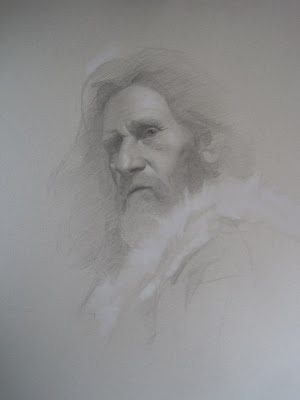
When I saw that his painting, The Trapper, won the very prestigious William Bouguereau Award in the recent Art Renewal Center International Salon, I was totally on board…a phenomenal painting indeed, and an award well deserved.
William Bouguereau (1825-1905) in his day was considered one of the world’s greatest painters. Many consider his paintings to be absolute perfection. But, as modernist thought replaced the academic, Bouguereau went the way of so many great artists…as did the training that helped produce them. Today, some of that solid training is being resurrected and we’re seeing the results. David Gluck’s work is one such example.

The Bouguereau award is given to a figurative piece that displays a strong sense of emotion and theme. Assessing whether The Trapper really met these stringent requirements, Gluck said, “The figure; clearly a man. The theme; manliness. Emotion; pfft, men don’t feel emotions. The only emotions I feel are rage and hunger, which usually go hand in hand.”
How did he feel about receiving the award, “I was actually extremely honored to have received this award. I have been a long time follower of the ARC and they have continued to support my career.”
Wondering what he thought of the great William B…”As far as William Bouguereau goes, I know everyone is a huge fan of the guy, but frolicking wussy peasant children never appealed to me. I will say, his technical proficiency is one to be admired.”
And now, more from Mr. Gluck.

How would you define your role as an artist? I fill up inconvenient blank spaces on a wall.
How does one find their individuality as an artist? It should come naturally. I found that living apart from most other artists and being primarily self-taught was helpful in finding my voice. Also, it helps to wear a hat.
Do you consider the process of painting more important than the result? Not at all, the result is what stands the test of time. Focus on the process is simply post-modernist thought.
What is the major thing you look for when selecting a subject? A fine balance between manliness and awesomeness.
How much of your work is intellectual vs. emotional…and how would you define the difference? I am not really a man with either quality, so I am unsure how to answer that.

What colors are most often found on your palette? My flesh tone palette is Yellow Ochre Pale, Vermillion, Ivory Black, Lead White, and Raw Umber. There is also a yellow stain that might be mustard, but I can’t be sure.
How do you decide on the dominating color key for a painting, and how do you maintain it? Using a limited palette makes it quite simple to harmonize your colors. I feel the color key is often picked in accordance to the mood I am trying to portray.
I love this one…
Do you paint in layers? I typically only wear layers when painting in a cold climate, but otherwise I wear gym shorts with no shirt while painting.
Does photography play a part in your work? Sometimes. I work from life whenever possible, photos when it simply isn’t an option.
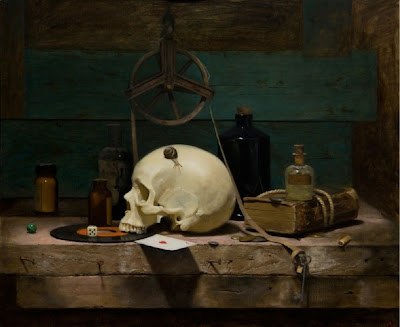
How much preliminary work do you do before beginning the final work? I would say at least half of a piece is in the planning. I always do a series of studies starting with thumbnails and preliminary drawings for tone and composition. I end with color studies before beginning on the final canvas. I try to leave very little to chance.
What is your major consideration when composing a painting? Composition of course is key. I try to work this out in the very early stages.
How does your work reflect your personality? Not very well. Most people are surprised I am an artist.
What constitutes classical painting and drawing, and why the resurgence at this time? Got me. Maybe it has to do with global warming or something.
You have the ability to paint incredibly beautiful works while using objects that are pretty common and not necessarily considered beautiful. What is the thought process behind that? Pretty objects and things don’t always make for a beautiful painting. It’s like the old saying…”It doesn’t matter what you say it’s how you say it”.
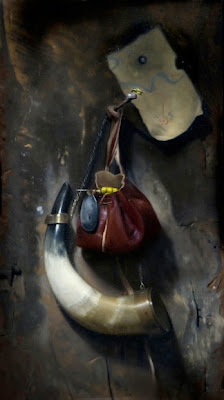
What advice do you have for a young artist/painter? Make your models bring their own towel to sit on. Otherwise you are stuck with a towel you have no idea what to do with.
What advice would you give a first-time collector? Buy my stuff.
If you could spend the day with any three artists, past or present, who would they be? My wife, Rembrandt, and Bob Ross. Actually, scratch Rembrandt, he doesn’t even speak English.
If you were stranded on an island, which three books would you want with you? One would be a choose your own adventure book to keep life interesting, Cooking with Beer, and maybe one super thick book to use as a seat.
Who has had the greatest influence on your career, and why? Easy answer, my wife. She is my primary influence being a fellow realist and the main contributor in inspiring my work.
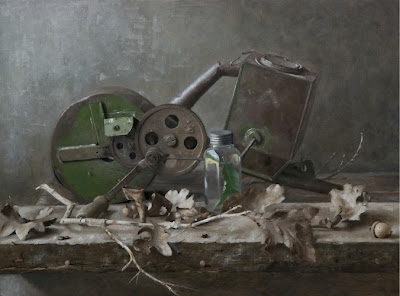
When you become discouraged and feel the well is dry, so to speak, what do you do? I call my good buddy Jack Daniels for moral support.
Why do you enter art competitions and how do you go about selecting paintings for them? I enter competitions to win sweet mullah. Apparently I enter the same painting in every competition.
Thanks David for participating in this interview and allowing me to share your fabulous, beautifully executed works. I’m sure we’ll be hearing more of you. I hope it’s good.
Abstract vs. Realism
Hello, Painting Friends,
I’ve been getting questions regarding composition. I’m happy to be getting that question since composition is such an important consideration – it’s right up there at the top of the list! However, that spot at the top must be shared with the element of mood and excitement, the emotion & vision that is unique to each of us and that only YOU can bring to YOUR painting. The “Nuts and Bolts” of painting must be balanced with Individual Personality.
Regardless of whether you are a beginning or advanced painter, here is a practice of preliminary study that will advance your compositional skills AND infuse the element of emotional content into your paintings!
Abstract vs. REALISM
 Here is my photo reference. The challenge is four-fold:
Here is my photo reference. The challenge is four-fold:
- Realistically represent the rocks, flowers, sun and shade.
- Convey feeling – the excitement of being surrounded by these glorious, golden flowers, the feel of the warm, spring sun and cool shade.
- Express the reality AND the illusory in my own personal painting style.
- Composition: maintain the first rule of composition & design which is asymmetry and create a value pattern.
To get loosened up, I painted this little abstract study – what an advantage it gave me!

- I did not concern myself with portraying any parts of the picture realistically. I squinted my eyes and sloshed in the colors and dark value pattern, then splattered white gouache.
- Instinctively I set the bottom boulder at a slant rather than the horizontal direction in the photo, which improved the composition.
- The quick, intuitive paint application allowed me the freedom to explore without worry the explosive action of the flowers contrasted with cool, blue shade that wasn’t exactly like the photo but what I saw in my mind’s eye.
- While it prepared me for the “real” painting, it was fun!

These three illustrations show the progression from photo-reference to abstract study to finished realistic painting. They have been “Photoshopped” so you don’t have to squint to see how the original value pattern has been carried through – but the darks also opened up to allow the viewer see into the shadows.
While I was using the abstract study to get in touch with the painting I had in mind on an emotional level, several extremely important Elements of Design were studied as well:
- value pattern – see how the darkest value creates a solid foundation for the basic composition
- asymmetry – asymmetrical design is achieved by placing shapes so that no shapes are centered nor equidistant
- movement – the linkage of shapes and values lead the eye through the painting
- repetition of similar shapes
- variation of shape and size within the assembly of repeated shapes
- color – color responsive to my emotional attachment to the location and memory of the day – and what I would call a “near-complement” color scheme
I consider this particular abstract study to be a finished painting in its own right. However, most of the studies of this nature I do are simply small sketch book studies. There are no rules except to relax and have fun with it. You simply must try it – it can make all the difference in the world!
Is There A Heaven For Paintings?
